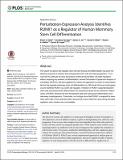Perturbation-Expression Analysis Identifies RUNX1 as a Regulator of Human Mammary Stem Cell Differentiation
Author(s)
Sanduja, Sandhya; Jin, Dexter X.; Sokol, Ethan Samuel; Miller, Daniel Handel; Mathis, Robert Austin; Gupta, Piyush; ... Show more Show less
DownloadSokol-2015-Perturbation-Express.pdf (2.004Mb)
PUBLISHER_CC
Publisher with Creative Commons License
Creative Commons Attribution
Terms of use
Metadata
Show full item recordAbstract
The search for genes that regulate stem cell self-renewal and differentiation has been hindered by a paucity of markers that uniquely label stem cells and early progenitors. To circumvent this difficulty we have developed a method that identifies cell-state regulators without requiring any markers of differentiation, termed Perturbation-Expression Analysis of Cell States (PEACS). We have applied this marker-free approach to screen for transcription factors that regulate mammary stem cell differentiation in a 3D model of tissue morphogenesis and identified RUNX1 as a stem cell regulator. Inhibition of RUNX1 expanded bipotent stem cells and blocked their differentiation into ductal and lobular tissue rudiments. Reactivation of RUNX1 allowed exit from the bipotent state and subsequent differentiation and mammary morphogenesis. Collectively, our findings show that RUNX1 is required for mammary stem cells to exit a bipotent state, and provide a new method for discovering cell-state regulators when markers are not available.
Date issued
2015-04Department
Massachusetts Institute of Technology. Department of Biology; Whitehead Institute for Biomedical Research; Koch Institute for Integrative Cancer Research at MITJournal
PLOS Computational Biology
Publisher
Public Library of Science
Citation
Sokol, Ethan S., Sandhya Sanduja, Dexter X. Jin, Daniel H. Miller, Robert A. Mathis, and Piyush B. Gupta. “Perturbation-Expression Analysis Identifies RUNX1 as a Regulator of Human Mammary Stem Cell Differentiation.” Edited by Sheng Zhong. PLoS Comput Biol 11, no. 4 (April 20, 2015): e1004161.
Version: Final published version
ISSN
1553-7358
1553-734X